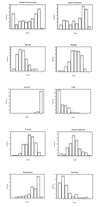Relative value to surgical patients and anesthesia providers of selected anesthesia related outcomes
- PMID: 12589710
- PMCID: PMC152656
- DOI: 10.1186/1472-6947-3-3
Relative value to surgical patients and anesthesia providers of selected anesthesia related outcomes
Abstract
Background: Anesthesia side effects are almost inevitable in most situations. In order to optimize the anesthetic experience from the patient's viewpoint, it makes intuitive sense to attempt to avoid the side effects that the patient fears the most.
Methods: We obtained rankings and quantitative estimates of the relative importance of nine experiences that commonly occur after anesthesia and surgery from 109 patients prior to their surgery and from 30 anesthesiologists.
Results: Pain was the most important thing to avoid, and subjects allocated a median of 25 dollars of an imaginary 100 dollars to avoiding it. Next came vomiting (20 dollars), nausea (10 dollars), urinary retention (5 dollars) , myalgia (2 dollars) and pruritus (2 dollars) . Avoiding blood transfusion, an awake anesthetic technique or postoperative somnolence was not given value by the group as a whole. Anesthesiologists valued perioperative experiences in the same way as patients.
Conclusions: Our results are comparable with those of previous studies in the area, and suggest that patients can prioritize the perioperative experiences they wish to avoid during their perioperative care. Such data, if obtained in the appropriate fashion, would enable anesthetic techniques to be compared using decision analysis.
Figures
References
-
- Macario A, et al. Which clinical anesthesia outcomes are important to avoid? The perspective of patients. Anesth Analg. 1999;89:652–8. - PubMed
-
- Gan TJ, et al. How much are patient willing to pay to avoid postoperative nausea and vomiting? Anesth Analg. 2001;92:393–400. - PubMed
-
- Fung D, Cohen MM. Measuring patient satisfaction with anesthesia care: A review of current methodology. Anesth Analg. 1998;87:1089–98. - PubMed
Publication types
MeSH terms
LinkOut - more resources
Full Text Sources
Medical


